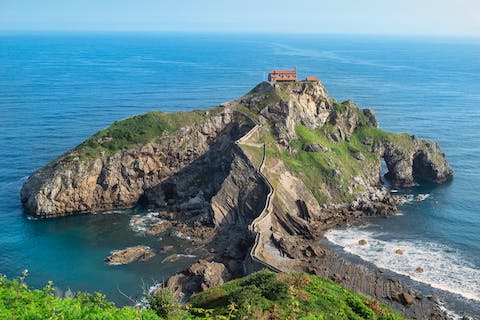Varsha Sharma is a farmer from the mountain area of Himachal Pradesh in north India. Her family has grown rice for over a hundred years. But, less rain and more water used by factories made it hard to grow rice. Seven years ago she tried a new type of rice and also started growing apples, but these changes caused more problems. The new rice grew more but it needed lots of added stuff which hurt the soil.
In 2018, Varsha started growing red rice. This rice has been grown in Himachal Pradesh for a long time but not many farmers grow it now. Red rice is strong and grows well without extra things. It is also good for you and sells for a good price. The government wants more red rice to be grown.
In West Bengal, another part of India, lots of rice is grown. They have over 5,000 types of rice but most are not grown anymore. Farmers want to grow more rice so they use new types of rice. But, these new types need lots of extra things and cost a lot.
Old types of rice are better suited to the local area and can grow even when there’s not much rain. Farmers who use old types of rice get free seeds from Mr Sinha’s group. They just have to give back some seeds after they grow their rice.
Rice is very important in India and they send lots of it to other countries. But in July, the government stopped sending white rice to other countries because it was too expensive in India. This happened because heavy rain hurt the rice plants.
Shankar Patnaik is another farmer who says farmers got too greedy and wanted to grow more rice. They used too many extra things which hurt the soil. He is trying out lots of old types of rice on his land. He says that some old types can grow a lot of rice without extra things.
He is also trying new ways to grow rice that don’t need as much water. One way is to let the fields fill with water, then let them dry out, and then fill them with water again. This way uses less water but needs more help from the government.
Prema Devi is a farmer from Uttarakhand who tried a new way to grow rice. She grows the young rice plants far apart from each other. This gives them more air and less competition for food and sunlight. This new way doubled her rice harvest to 100kg a year. She was surprised that such a simple change could make such a big difference.
Original news source: Back to the future for India’s rice farmers (BBC)
Listen
Slow
Normal
Fast
Group or Classroom Activities
Warm-up Activities:
– Vocabulary Building: Farming Terms
Instructions: Have students look at the article and identify any words related to farming (e.g., farmer, rice, soil, seeds, harvest, etc.). Write these words on the board and discuss their meanings in simple English. Then, ask students to use these words to write a simple sentence about farming.
– Story Retelling
Instructions: Divide students into pairs. Ask one student to read the article carefully and then explain the story to their partner in their own words. Encourage them to use simple sentences and vocabulary that they are comfortable with.
– Picture Descriptions
Instructions: Ask students to draw a scene from the article, such as Varsha Sharma trying to grow red rice, or Prema Devi spacing out her young rice plants. Then, have them describe their picture to the class using simple sentences, such as “This is Varsha. She is growing red rice.” or “This is Prema. She is planting rice.” This will help students practice sentence construction and descriptive language.
Comprehension Questions:
1. Where is Varsha Sharma from and what does she do?
2. What did Varsha Sharma start growing in 2018 and why?
3. What is special about red rice?
4. In West Bengal, what is the problem with new types of rice?
5. Who gives free seeds to farmers who use old types of rice?
6. Why did the government stop sending white rice to other countries in July?
7. What is Shankar Patnaik doing to grow more rice without hurting the soil?
8. What new way did Prema Devi try to grow rice and what happened?
Go to answers ⇩
Listen and Fill in the Gaps:
Varsha Sharma is a (1)______ from the mountain area of Himachal Pradesh in north India. Her family has grown rice for over a hundred years. But, less rain and more water used by factories made it hard to grow rice. Seven years ago she tried a new type of rice and also started growing apples, but these changes caused more problems. The new rice grew more but it needed lots of added stuff which hurt the soil.
In 2018, Varsha started growing red rice. This rice has been grown in Himachal Pradesh for a long time but not many farmers grow it now. Red rice is strong and grows well without extra things. It is also good for you and sells for a good price. The government wants more red rice to be (2)______.
In West Bengal, another part of India, lots of rice is grown. They have over 5,000 types of rice but most are not grown anymore. Farmers want to grow more rice so they use new types of rice. But, these new types need lots of extra things and cost a lot.
Old types of rice are better suited to the local area and can grow even when there’s not much rain. Farmers who use old types of rice get free seeds from Mr Sinha’s group. They just have to give back some seeds after they grow their (3)______.
Rice is very important in India and they send lots of it to other countries. But in July, the government stopped sending white rice to other countries because it was too expensive in India. This happened because heavy rain hurt the rice (4)______.
Shankar Patnaik is another farmer who says farmers got too greedy and wanted to grow more rice. They used too many extra things which hurt the soil. He is trying out lots of old types of rice on his land. He says that some old types can grow a lot of rice without extra things.
He is also trying new ways to grow rice that don’t need as much water. One way is to let the fields fill with water, then let them dry out, and then fill them with water again. This way uses less water but needs more help from the (5)______.
Prema Devi is a farmer from Uttarakhand who tried a new way to grow rice. She grows the young rice plants far apart from each other. This gives them more air and less competition for food and sunlight. This new way doubled her rice harvest to 100kg a year. She was surprised that such a simple change could make such a big (6)______.
Go to answers ⇩
Discussion Questions:
Students can ask a partner these questions, or discuss them as a group.
1. Do you know where rice comes from?
2. Have you ever tried to grow a plant? What happened?
3. Varsha Sharma switched to growing red rice. If you were a farmer, what would you want to grow?
4. Why do you think some farmers stopped growing old types of rice?
5. Do you think it’s important to take care of the soil? Why or why not?
6. How would you feel if you grew a plant and it did not grow well?
7. Why do you think red rice is good?
8. How do you think a farmer feels when they can’t grow their crops?
9. Have you ever eaten red rice? Did you like it?
10. Why do you think it’s good to try new ways to grow plants?
11. What do you think about using less water to grow plants?
12. Can you think of a plant that doesn’t need a lot of water?
13. Prema Devi was surprised when she grew more rice. Have you ever been surprised like that?
14. What would you do if something you liked became too expensive?
15. Why do you think the government stopped sending white rice to other countries?
Individual Activities
Vocabulary Meanings:
Match each word to its meaning.
Words:
1. farmer
2. mountain
3. rice
4. factories
5. soil
6. government
7. seeds
8. harvest
Shuffled Meanings:
A) A big building where things are made
B) The top part of a hill or high land
C) A person who grows food on a piece of land
D) The brown stuff that plants grow in
E) The time when you pick the food that has grown
F) Tiny things that you plant in the ground to grow new plants
G) The group of people who make rules and decisions for a country
H) A food that comes from a plant and is eaten a lot in many countries
Go to answers ⇩
Multiple Choice Questions:
1. Where is Varsha Sharma from?
(a) West Bengal
(b) Uttarakhand
(c) Himachal Pradesh
(d) Southern India
2. What did Varsha start growing in 2018?
(a) Apples
(b) Red rice
(c) White rice
(d) New type of rice
3. What is the problem with the new types of rice?
(a) They are too expensive
(b) They grow too much
(c) They need lots of extra things
(d) They are not good for health
4. Who gives free seeds to farmers who use old types of rice?
(a) The government
(b) Mr Sinha’s group
(c) Varsha Sharma
(d) Shankar Patnaik
5. Why did the government stop sending white rice to other countries in July?
(a) Because it was too expensive in India
(b) Because they wanted to grow more red rice
(c) Because it was not good for health
(d) Because they did not have enough rice
6. What is Shankar Patnaik trying on his land?
(a) New types of rice
(b) Old types of rice
(c) Red rice
(d) White rice
7. What new way of growing rice is Shankar Patnaik trying?
(a) Growing rice far apart from each other
(b) Letting the fields fill with water, then dry out, and then fill them with water again
(c) Using more extra things
(d) Growing rice in the mountains
8. How much rice does Prema Devi harvest a year with her new way of growing rice?
(a) 50kg
(b) 200kg
(c) 150kg
(d) 100kg
Go to answers ⇩
True or False Questions:
1. Varsha Sharma is a farmer from the desert area of India.
2. Varsha started growing red rice in 2018.
3. The government doesn’t want more red rice to be grown.
4. In West Bengal, they have over 10,000 types of rice.
5. Old types of rice can grow even when there’s not much rain.
6. The government stopped sending white rice to other countries because it was too cheap in India.
7. Shankar Patnaik is trying out lots of old types of rice on his land.
8. Prema Devi’s new way of growing rice made her harvest less.
Go to answers ⇩
Write a Summary:
Write a summary of this news article in two sentences.
Writing Questions:
Answer the following questions. Write as much as you can for each answer.
1. What did Varsha Sharma’s family grow for over a hundred years?
2. Why did Varsha start growing red rice?
3. What happens when farmers use new types of rice that need lots of extra things?
4. How do farmers who use old types of rice get their seeds?
5. What did the government do in July because of heavy rain?
Answers
Comprehension Question Answers:
1. Where is Varsha Sharma from and what does she do?
Varsha Sharma is a farmer from the mountain area of Himachal Pradesh in north India.
2. What did Varsha Sharma start growing in 2018 and why?
In 2018, Varsha started growing red rice because it is strong, grows well, and sells for a good price.
3. What is special about red rice?
Red rice is strong and grows well without extra things. It is also good for you and sells for a good price.
4. In West Bengal, what is the problem with new types of rice?
The new types of rice need lots of extra things and cost a lot.
5. Who gives free seeds to farmers who use old types of rice?
Mr Sinha’s group gives free seeds to farmers who use old types of rice.
6. Why did the government stop sending white rice to other countries in July?
The government stopped sending white rice to other countries because it was too expensive in India.
7. What is Shankar Patnaik doing to grow more rice without hurting the soil?
Shankar Patnaik is trying out lots of old types of rice on his land. He says that some old types can grow a lot of rice without extra things.
8. What new way did Prema Devi try to grow rice and what happened?
Prema Devi tried a new way to grow rice by growing the young rice plants far apart from each other. This new way doubled her rice harvest to 100kg a year.
Go back to questions ⇧
Listen and Fill in the Gaps Answers:
1. farmer
2. grown
3. rice
4. plants
5. government
6. difference
7. surprised
Go back to questions ⇧
Vocabulary Meanings Answers:
1. farmer
Answer: C) A person who grows food on a piece of land
2. mountain
Answer: B) The top part of a hill or high land
3. rice
Answer: H) A food that comes from a plant and is eaten a lot in many countries
4. factories
Answer: A) A big building where things are made
5. soil
Answer: D) The brown stuff that plants grow in
6. government
Answer: G) The group of people who make rules and decisions for a country
7. seeds
Answer: F) Tiny things that you plant in the ground to grow new plants
8. harvest
Answer: E) The time when you pick the food that has grown
Go back to questions ⇧
Multiple Choice Answers:
1. Where is Varsha Sharma from?
Answer: (c) Himachal Pradesh
2. What did Varsha start growing in 2018?
Answer: (b) Red rice
3. What is the problem with the new types of rice?
Answer: (c) They need lots of extra things
4. Who gives free seeds to farmers who use old types of rice?
Answer: (b) Mr Sinha’s group
5. Why did the government stop sending white rice to other countries in July?
Answer: (a) Because it was too expensive in India
6. What is Shankar Patnaik trying on his land?
Answer: (b) Old types of rice
7. What new way of growing rice is Shankar Patnaik trying?
Answer: (b) Letting the fields fill with water, then dry out, and then fill them with water again
8. How much rice does Prema Devi harvest a year with her new way of growing rice?
Answer: (d) 100kg
Go back to questions ⇧
True or False Answers:
1. Varsha Sharma is a farmer from the desert area of India.
Answer: False
2. Varsha started growing red rice in 2018.
Answer: True
3. The government doesn’t want more red rice to be grown.
Answer: False
4. In West Bengal, they have over 10,000 types of rice.
Answer: False
5. Old types of rice can grow even when there’s not much rain.
Answer: True
6. The government stopped sending white rice to other countries because it was too cheap in India.
Answer: False
7. Shankar Patnaik is trying out lots of old types of rice on his land.
Answer: True
8. Prema Devi’s new way of growing rice made her harvest less.
Answer: False
Go back to questions ⇧












